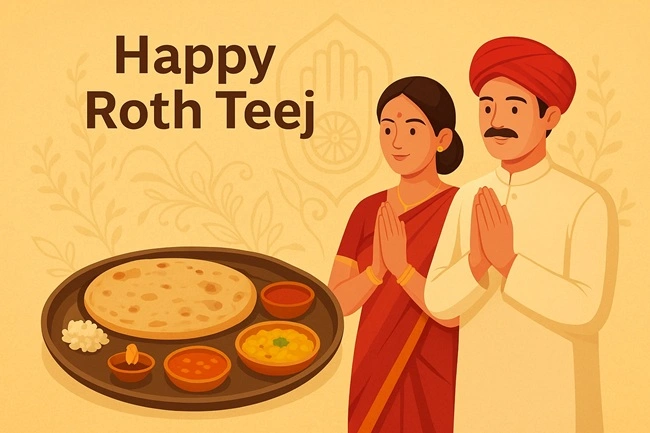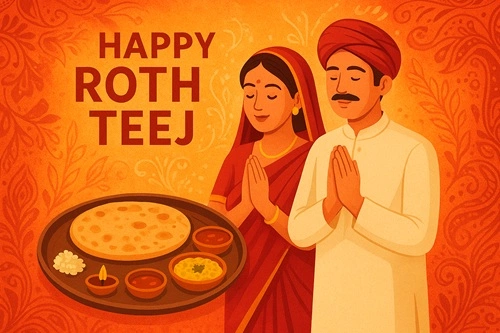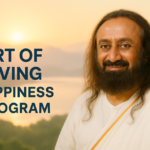Festivals in Jainism are not just about rituals, they are a way of life, a path to purify the soul, and a reminder of the eternal teachings of Lord Mahavira. One such deeply spiritual festival is Roth Teej. Celebrated with devotion and simplicity, Roth Teej holds immense significance in Jain households. It is not only about fasting and prayers but also about cultivating gratitude, discipline, and spiritual awareness.
In this blog, let us explore what Roth Teej is, why it is celebrated, when it is observed, how Jains celebrate it across the world, and the special significance of food (Roth) prepared on this day.

What is Roth Teej?
Roth Teej is a Jain festival observed on the third day (Tritiya) of Shukla Paksha in the holy month of Bhadrapada (as per the Hindu lunar calendar). It usually falls in August–September, right before the festival of Paryushan in many Jain communities.
The word “Roth” means flat bread made of wheat flour and ghee, while “Teej” refers to the third day of the lunar fortnight. Hence, this festival gets its name from the simple yet sacred food (roth) prepared and consumed after completing the fast.
Significance of Roth Teej in Jainism
The story behind Roth Teej is rooted in faith, simplicity, and devotion. According to Jain traditions:
- Once during a time of famine, people were unable to prepare elaborate meals for monks and saints.
- Instead, they prepared a simple flatbread (roth) with wheat flour and ghee and humbly offered it as alms (aahaar daan).
- This act of devotion and selfless offering pleased the monks, and the day was remembered as Roth Teej.
The festival thus reminds us of the values of contentment, gratitude, and humility. It emphasizes that it is not the grandeur of offerings but the purity of intention that matters.
Why is Roth Teej Celebrated?
Roth Teej is celebrated to:
- Honor the tradition of simple living and high thinking.
- Practice austerity, fasting, and devotion to cleanse the soul.
- Express gratitude towards Tirthankaras and saints who guide humanity on the path of non-violence and truth.
- Strengthen discipline by following specific food rules and fasting rituals.
- Remind us that spiritual upliftment does not require material abundance.
When is Roth Teej Celebrated?
Roth Teej falls on the Tritiya (third day) of Bhadrapada Shukla Paksha.
- In 2025, Roth Teej will be observed on 26th August 2025 (Tuesday).
- The festival date varies every year according to the lunar calendar.
How is Roth Teej Celebrated?
Jains around the world observe Roth Teej with deep devotion and spiritual discipline. The day generally includes:
- Fasting (Upvaas) – Many devotees observe a full day fast (without food and sometimes even water) or consume only boiled water at specific times.
- Puja and Prayers – Temples are decorated, and special prayers or discourses (pravachans) are held. Devotees listen to stories of Roth Teej to understand its essence.
- Preparation of Roth – In the evening, after completing the fast, a simple roth (flatbread made of wheat flour and ghee) is prepared and consumed along with just one vegetable curry.
- Ek-bhukti (One Meal) – Some families take only a single meal of roth and sabzi, keeping the meal sattvik (pure and simple).
- Charity and Punya (Good Deeds) – Many Jains donate food, clothes, or essentials to the needy as part of their spiritual duty.
Celebration of Roth Teej Across the World
- In India: Roth Teej is widely celebrated in Rajasthan, Gujarat, Madhya Pradesh, and Uttar Pradesh among Jain communities. Families gather, cook roth, and narrate the story behind this festival.
- In Abroad Communities: Jains living in the USA, UK, Canada, UAE, and other countries celebrate Roth Teej in community centers and temples. They come together for group prayers, spiritual talks, and preparation of roth as prasadam.
- Modern Adaptations: While the core values remain intact, some Jains prepare roth in healthier variations using less ghee, but the essence of simplicity is always preserved.
Special Food of Roth Teej
The central element of Roth Teej is the Roth bread.
Ingredients of Roth:
- Wheat flour
- Ghee (clarified butter)
- A pinch of salt
- Water
Method:
- The dough is prepared using wheat flour, ghee, and water.
- Small thick rotis are rolled out and cooked on a flat pan.
- Once golden brown, they are offered in prayer and then consumed with a simple curry.
The specialty is that no elaborate dishes, sweets, or multiple items are cooked, only roth and one vegetable dish. This simplicity reflects the spirit of detachment and purity.
What Does Roth Teej Teach Us?
The festival of Roth Teej teaches timeless lessons that hold relevance even today:
- Simplicity is strength – True devotion lies in humility, not extravagance.
- Contentment – Even simple food prepared with love and devotion is enough.
- Gratitude – Be thankful for what we have rather than focusing on what we lack.
- Discipline – Fasting and simple meals bring balance to the body and mind.
- Equality – Everyone, regardless of wealth or status, celebrates with the same simple roth.
Message of Roth Teej
Roth Teej reminds us that life’s true wealth lies not in material possessions but in spiritual growth, gratitude, and inner peace. In today’s fast-paced world, this festival inspires us to slow down, embrace simplicity, and live with a heart full of devotion.
As Lord Mahavira said:
“Live and allow others to live; hurt no one; life is dear to all living beings.”
On Roth Teej, let us not only fast from food but also from anger, ego, and negativity.
FAQs on Roth Teej
Q1. What is the main ritual of Roth Teej?
The main ritual is preparing and eating roth (a simple flatbread) with one vegetable after fasting and prayers.
Q2. Can Roth Teej be celebrated by all Jains?
Yes, Roth Teej is celebrated by both Shwetambar and Digambar Jains with equal devotion.
Q3. Is Roth Teej only about food restrictions?
No, it is about spiritual discipline, gratitude, humility, and learning the importance of simplicity.
Q4. What food is prepared on Roth Teej?
Only roth (flatbread) and a single curry are prepared, nothing more.
Q5. Is Roth Teej connected to Paryushan?
Yes, Roth Teej falls just before Paryushan, preparing devotees for deeper spiritual practices.
For more such interesting read on Spirituality and Wellness, Follow Popnewsblend.com.

Hi, I’m Prashant Jain — a curious soul, storyteller, and content creator at heart.I’ve always been drawn to the world of entertainment, travel, sports, health & lifestyle — not just as a writer, but as someone who genuinely lives these experiences. Whether I’m binge-watching the latest OTT series, exploring offbeat spiritual destinations in India, or diving deep into wellness routines and cricket match insights, I love sharing what I discover with like-minded readers.
PopNewsBlend is my way of blending personal journeys with meaningful stories — ones that inform, inspire, and keep you ahead of the curve. Everything I write comes from real observations, hands-on experiences, and a deep passion for understanding the world around us.
Discover more from Popnewsblend
Subscribe to get the latest posts sent to your email.







